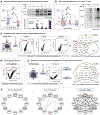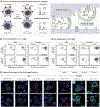Microenvironment mapping via Dexter energy transfer on immune cells
- PMID: 32139536
- PMCID: PMC7336666
- DOI: 10.1126/science.aay4106
Microenvironment mapping via Dexter energy transfer on immune cells
Abstract
Many disease pathologies can be understood through the elucidation of localized biomolecular networks, or microenvironments. To this end, enzymatic proximity labeling platforms are broadly applied for mapping the wider spatial relationships in subcellular architectures. However, technologies that can map microenvironments with higher precision have long been sought. Here, we describe a microenvironment-mapping platform that exploits photocatalytic carbene generation to selectively identify protein-protein interactions on cell membranes, an approach we term MicroMap (μMap). By using a photocatalyst-antibody conjugate to spatially localize carbene generation, we demonstrate selective labeling of antibody binding targets and their microenvironment protein neighbors. This technique identified the constituent proteins of the programmed-death ligand 1 (PD-L1) microenvironment in live lymphocytes and selectively labeled within an immunosynaptic junction.
Copyright © 2020 The Authors, some rights reserved; exclusive licensee American Association for the Advancement of Science. No claim to original U.S. Government Works.
Conflict of interest statement
Figures




Comment in
-
Method Enables Nanoscale Mapping of Protein Interactions on Live Cells.Cancer Discov. 2020 May;10(5):OF13. doi: 10.1158/2159-8290.CD-RW2020-057. Epub 2020 Mar 13. Cancer Discov. 2020. PMID: 32169879
References
-
- Lundberg E, Borner GHH, Nat. Rev. Mol. Cell Biol 20, 285–302 (2019). - PubMed
-
- Bauer NC, Doetsch PW, Corbett AH, Traffic 16,1039–1061 (2015). - PubMed
-
- Minter RR, Sandercock AM, Rust SJ, Drug Discov. Today. Technol 23, 83–90 (2017). - PubMed
-
- Johnson DS, Mortazavi A, Myers RM, Wold B, Science 316, 1497–1502 (2007). - PubMed
Publication types
MeSH terms
Substances
Grants and funding
LinkOut - more resources
Full Text Sources
Other Literature Sources
Research Materials

